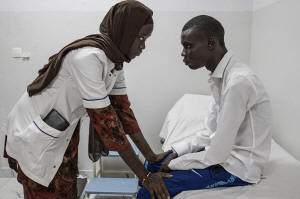Rare diseases often go undiagnosed or untreated in parts of Africa. A
project seeks to change that
[April 28, 2025]
By SARAH GELBARD
DAKAR, Senegal (AP) — Ndeye Lam visits the cemetery often, praying and
gently touching the seashells laid out across her daughter’s gravesite.
“Mariama will always be here,” she said, stepping away from the grave
and onto a path that winds through rows of monuments outlined with white
tile, stone and sand.
At home, Lam and her husband Pathé smiled over an old video clip of
their daughter beaming as she celebrated her 13th birthday with cake and
sparklers. When the girl was little, she loved to play. By 13, her
muscles had weakened, her spine had curved and stiffened and in her last
months, she struggled increasingly to breathe.
She visited Fann hospital in Dakar, where neurologist Dr. Pedro
Rodriguez Cruz measured her lung capacity. He suspects Mariama had
SELENON-related myopathy, a muscular dystrophy that causes severe
respiratory compromise. A new BiPAP machine might have helped to ease
her breathing, but it was too late.
Globally, more than 350 million people live with rare diseases, most of
them caused by a misstep hidden within their genes. Some conditions can
be caught early and treated—but in parts of Africa where population data
and resources are scarce, many people go undiagnosed. Rodriguez is
trying to change that by connecting patients with genetic testing and
medical support, while gathering key data from those patients and their
families.
“Most rare disease data has been collected from people of European
ancestry, so we have very little knowledge about what’s happening in
other parts of the world, mainly in Africa,” Rodriguez said.
His research is funded by organizations including the La Caixa
Foundation in Spain and the National Ataxia Foundation in the United
States. And he has consulted with scientists in China, France, Boston,
and elsewhere around the world, documenting rare diseases and novel
disease-causing gene variants.

That research is creating a library of genetic data for scientists and
clinicians. Patients in Senegal are benefiting, too, with a path to
diagnosis.
Genetic testing and diagnosis can be life-saving
In Guediawaye, Fatoumata Binta Sané’s daughter Aissata has glutaric
acidemia type I, an inherited disorder in which the body can’t process
certain proteins properly. Her arms and legs are tightly drawn up toward
her chest. She can’t walk or reach for things, speak, sit on her own or
hold her head up. Sané cradles Aissata in her arms constantly, and the
8-year-old smiles at the sound of her mother’s voice.
In the U.S., newborns are screened for treatable genetic conditions. In
Senegal, newborn screening is not routine. Infants who appear healthy at
birth might go undiagnosed and experience irreversible decline. Glutaric
acidemia type I, for example, can cause brain damage, seizures, coma and
early death.
Sané is waiting for genetic testing results for Aissata’s one-year-old
sister Aminata. Patients can live long, healthy lives if they start
treatment before the onset of symptoms. That includes following a strict
diet, avoiding protein-rich foods like nuts, fish and meat and taking
the supplement L-carnitine. Though consultation with Rodriguez was free,
lifelong treatment is not. If Aminata shares her sister’s disease, Sané
will need government assistance to buy medication.
Prof. Moustapha Ndiaye, head of the neurology department at Fann, hopes
young physicians will graduate prepared to assist rare disease patients
not just in Senegal but in other African countries.
“Students travel from across Africa to study here,” Ndiaye said.
At the start of her career, Dr. Henriette Senghor saw patients who were
hospitalized for months. Some died, and no one knew why.
“There was this problem—there was this void,” said Senghor, who’s now
training with Rodriguez.
In 2021, Rodriguez established a partnership between the Cheikh Anta
Diop University of Dakar and CNAG, the National Center for Genomic
Analysis in Barcelona. Rodriguez collects patients’ blood samples and
delivers the extracted DNA to Barcelona, where scientists sequence it,
storing the answers it holds in a large database. Almost 1,300
participants—patients and families—have enrolled in his study of rare
disease in West Africa.
[to top of second column]
|

Neurology student Henriette Dieng examines Abdou Diop, a patient
with genetic neuropathy at Pedro Rodriguez's clinic in Dakar,
Senegal, Friday, Jan. 10, 2025. (AP Photo/Annika Hammerschlag)
 Families cross borders for care
In the Gambia, Fatou Samba’s sons Adama, 8, and Gibriel, 4, like to
play soccer and feed the sheep in their backyard. On a recent
afternoon, they took turns playing with a toy airplane and a globe.
Adama, who hopes to be a pilot, pointed to where he wanted to go:
the U.S. Outside, he started to climb a pile of bicycles propped up
against the wall, and Gibriel followed.
“We’re climbing Mount Everest,” Adama said.
Standing on a bicycle wheel, Adama hesitated. Samba reached for him,
setting him down on solid ground. There is a tiny scar on his
forehead where broken skin has been stitched back together. Last
year, Samba couldn’t explain his frequent falling, so she sought
answers in Dakar. Rodriguez confirmed Adama had Duchenne muscular
dystrophy. Gibriel's genetic test results are pending. Children
often lose the ability to run or climb stairs first, and later can’t
walk or raise their arms. In adulthood, they develop heart and
breathing problems.
Both boys are taking corticosteroids, which can slow disease
progression for patients diagnosed early.
“Without the medication, it would have been terrible. Once we
started, after a few weeks we saw improvement,” Samba said. “Doctors
are destined to investigate (the disease) and find a cure … I pray
doctors will find a cure.”
Data is the first step
Back at Fann Hospital, Rodriguez and Senghor consult with Woly Diene,
25, and her mother and brother. When Diene was 15, she started
falling at school. Soon, she felt pain throughout her body. She
couldn’t move. She lost her hearing, the strength in her hands and
control of the muscles in her face.
Diene, who comes from a rural village in Senegal, has riboflavin
transporter deficiency. High doses of vitamin B2—a supplement
available on Amazon—can slow, stop and even reverse damage from this
condition that is fatal without treatment.
Diene took her first dose when she was diagnosed in August 2023. She
still has some difficulty hearing, but Diene is walking again. She
has regained the strength in her face and hands. Diene’s brother
Thierno said vitamin B2 is expensive, but he knows his sister needs
it for the rest of her life.
“I am happy,” Diene said, smiling. “I hope to keep improving.”
While efforts like these help patients, they also allow doctors to
collect data—and that’s vital for rare disease research, policy and
drug development, said Lauren Moore, chief scientific officer at the
National Ataxia Foundation.

“The most prevalent diseases get the most attention and the most
funding,” she said. “Data … really is the first step.”
A $50,000 grant from the foundation allows Rodriguez and colleagues
to enroll study participants in Senegal and Nigeria with inherited
ataxias—which can lead to muscle weakness, loss of mobility, hearing
and vision difficulties and life-shortening heart problems.
The USAID cuts have not affected his research, but grant awards are
limited. Rodriguez, Senghor and Rokhaya Ndiaye, professor of human
genetics at the University of Dakar, are making plans to ensure
genetic testing continues in Senegal.
Global collaboration is essential, said Ndiaye—and strengthening
local infrastructure is just as important.
“The need is there,” she said. “And we have a lot of hope.”
All contents © copyright 2025 Associated Press. All rights reserved |